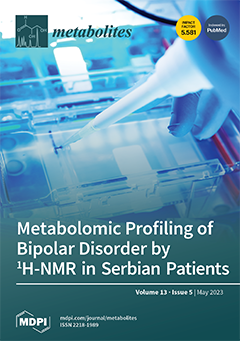Computational modeling and simulation of biological systems have become valuable tools for understanding and predicting cellular performance and phenotype generation. This work aimed to construct, model, and dynamically simulate the virulence factor pyoverdine (PVD) biosynthesis in
Pseudomonas aeruginosa through a systemic approach, considering that the metabolic pathway of PVD synthesis is regulated by the quorum-sensing (QS) phenomenon. The methodology comprised three main stages: (i) Construction, modeling, and validation of the QS gene regulatory network that controls PVD synthesis in
P. aeruginosa strain PAO1; (ii) construction, curating, and modeling of the metabolic network of
P. aeruginosa using the flux balance analysis (FBA) approach; (iii) integration and modeling of these two networks into an integrative model using the dynamic flux balance analysis (DFBA) approximation, followed, finally, by an in vitro validation of the integrated model for PVD synthesis in
P. aeruginosa as a function of QS signaling. The QS gene network, constructed using the standard System Biology Markup Language, comprised 114 chemical species and 103 reactions and was modeled as a deterministic system following the kinetic based on mass action law. This model showed that the higher the bacterial growth, the higher the extracellular concentration of QS signal molecules, thus emulating the natural behavior of
P. aeruginosa PAO1. The
P. aeruginosa metabolic network model was constructed based on the iMO1056 model, the
P. aeruginosa PAO1 strain genomic annotation, and the metabolic pathway of PVD synthesis. The metabolic network model included the PVD synthesis, transport, exchange reactions, and the QS signal molecules. This metabolic network model was curated and then modeled under the FBA approximation, using biomass maximization as the objective function (optimization problem, a term borrowed from the engineering field). Next, chemical reactions shared by both network models were chosen to combine them into an integrative model. To this end, the fluxes of these reactions, obtained from the QS network model, were fixed in the metabolic network model as constraints of the optimization problem using the DFBA approximation. Finally, simulations of the integrative model (CCBM1146, comprising 1123 reactions and 880 metabolites) were run using the DFBA approximation to get (i) the flux profile for each reaction, (ii) the bacterial growth profile, (iii) the biomass profile, and (iv) the concentration profiles of metabolites of interest such as glucose, PVD, and QS signal molecules. The CCBM1146 model showed that the QS phenomenon directly influences the
P. aeruginosa metabolism to PVD biosynthesis as a function of the change in QS signal intensity. The CCBM1146 model made it possible to characterize and explain the complex and emergent behavior generated by the interactions between the two networks, which would have been impossible to do by studying each system’s individual components or scales separately. This work is the first in silico report of an integrative model comprising the QS gene regulatory network and the metabolic network of
P. aeruginosa.
Full article






